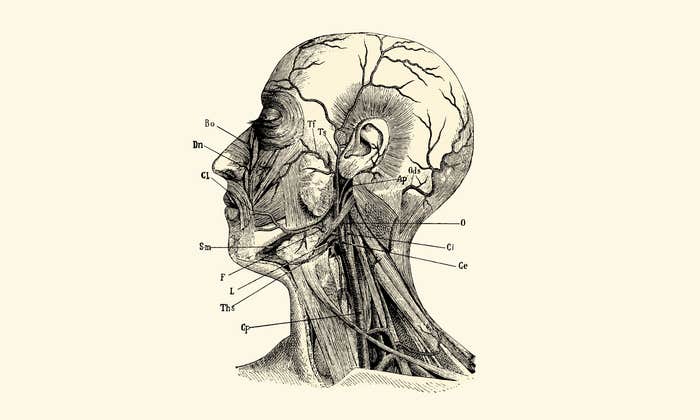The squeak in my mom’s voice seemed strange, but not worrisome. When we spoke on the phone, she sounded like she had inhaled helium. An initial doctor’s evaluation revealed nothing. And it wasn’t until many weeks later, when she started having trouble swallowing one night at dinner, that alarm bells started to go off for our family.
She went to the drop-in health clinic on the small island in British Columbia where my family has a vacation home. The nurse looked at her swollen neck, felt a lump, and told her to rush to the ferry—she needed to get to the nearest hospital right away.
From there, she would have to move to a hospital in Vancouver, where my parents live. While my dad drove back to the vacation home to collect their clothes and other belongings, the results of my mother’s biopsy came back. A tumor the size of a tennis ball had grown in her throat, and it was cancerous. I talked to my mother on the phone just minutes after she found out, and I’ve never heard her sound so scared and alone.
More tests brought on more bad news: The diagnosis was worse than we could have possibly imagined. It was anaplastic thyroid cancer, or ATC, and the tumor had metastasized to her lungs. I reached out to Robert Smallridge, an endocrinologist at the Mayo Clinic, for advice following my Mom’s diagnosis, and he told me that ATC has a time from diagnosis to death that is unparalleled by any other malignancy—less than five months for the majority of patients. “Looking over the cancer landscape, this is about as bad as it gets,” Smallridge said.
Less than two months later, on Sept. 10, 2012, my mother was dead. She would miss my October wedding. She would never meet my brother’s son, her first grandchild, born that December.
I’ve since learned about a variety of drugs that are being developed to fight ATC—and I’ve decided that those development efforts should stop. Here’s why.
In 2007, a California company called Oxigene decided to come to the rescue of patients afflicted with ATC. They launched an ambitious trial called FACT to test an experimental drug, Zybrestat—the first in a new class of compounds that target and destroy the blood vessels that feed cancer cells. Zybrestat had shown promise: In an earlier study, a 54-year-old man with ATC had received the drug, then lived for 15 years post-treatment before dying in 2012 of unrelated causes.
Yet doctors involved in the FACT trial struggled to find study subjects. And even when they identified interested patients, ATC’s breakneck pace of growth meant that many would-be participants saw their cancers progress to the point that they were too sick to take part. “Time moves incredibly fast for these patients,” says Peter Langecker, who served as president and CEO of Oxigene until May of this year.
Oxigene ultimately managed to recruit 80 patients—fewer than half the number it had hoped for, but still enough to make the FACT trial the largest randomized clinical study ever conducted in ATC. And although trial participants treated with Zybrestat lived longer than people in the control arm—with one-year survival rates of 27 percent and 9 percent, respectively—the trial was too small to robustly show whether this survival benefit could be chalked up to the drug or to chance.1

To meet the statistical threshold necessary to prove Zybrestat’s potential, the U.S. Food and Drug Administration told Oxigene that the company would need to run a 300-patient trial. After having spent as much as $40 million for the FACT study, and estimating the high cost of a larger trial, Oxigene gave up on ATC and opted to pursue Zybrestat for the treatment of common ovarian cancer instead.
Oxigene’s failure stemmed from ATC’s two-hit combo—rarity and aggressiveness—which creates immense logistical hurdles to running clinical trials. “You’re battling a mortal disease that is rapidly lethal and for which there is such a paucity of cases,” says Julie Sosa, a surgical oncologist at the Duke Cancer Institute who led the FACT study.
As a result, trials become extremely expensive, sometimes requiring a combination of government and industry support. For example, the U.S.-Israeli firm Immune Pharmaceuticals is investigating a drug called crolibulin that kills ATC tumors in much the same way as Zybrestat. Immune Pharmaceuticals is now recruiting patients in a trial on the drug—yet it’s the U.S. government, through the National Institutes of Health (NIH), that is funding the study, and not investors hoping for a return on their dollar. Stephane Allard, the former chief medical officer of Immune, acknowledges that the company would not have pursued ATC without federal funding.
Scientists need to abandon the assumption that every medical challenge must be overcome by a direct attack.
The call for more such funding has, by now, become a familiar refrain. “Patients and their families and friends need to raise money to help fund essential projects,” wrote reporter Amy Dockser Marcus in the journal Health Affairs, after her mother died of a rare type of gallbladder cancer.2 Funding was the main message from the Citizens’ Committee for the Conquest of Cancer, which lobbied the U.S. government to launch the War on Cancer in 1971. And it remains the mantra today for organizations like the Leukemia & Lymphoma Society and the Multiple Myeloma Research Foundation.
All of which explains why the NIH has spent approximately $130 billion on cancer research since its “War” began—an investment made under the premise that diseases are beatable given enough money put into research and development. “I give up,” are three words rarely uttered by doctors, scientists, and politicians, and so they continue to try.
But for rare, aggressive cancers like ATC, I argue that giving up is exactly what they should do.
This week, at the International Gynecologic Cancer Society Meeting in Australia, Oxigene presented results from a 107-person trial showing that Zybrestat significantly reduced the rate of growth of ovarian tumors. This trial outcome moved the drug one step closer to market approval for women with ovarian cancer. It also placed the drug within the reach of ATC patients. That’s because of a practice called off-label drug prescriptions: Doctors can choose to prescribe an FDA-approved cancer drug to a patient suffering from a cancer other than the one for which the drug was approved.
There’s evidence that off-label drug repositioning can help ATC patients. Three independent clinical teams recently published case reports documenting dramatic responses among ATC patients treated with the kidney and gastrointestinal cancer drug Sutent.3,4,5 In another study, more than a third of ATC patients lived one year or longer when given the leukemia drug Gleevec—a survival statistic that might not sound impressive, but it’s often better than what’s observed with the chemotherapy drugs currently given to people with ATC.6
What’s more, off-label prescriptions have been aided by genomic medicine. For example, oncologists last year reported the case of a man with ATC who received a skin cancer drug, called Zelboraf, after a DNA test revealed a mutation indicating that he’d be a likely responder. One month post-treatment, his metastatic lung and bone lesions had practically vanished.7 With genetic profiling, doctors can now “distribute patients with anaplastic thyroid cancer to the therapy that makes sense for them,” says Nikhil Wagle, a cancer geneticist at the Dana-Farber Cancer Institute who successfully treated a woman with ATC with the help of DNA sequencing and another off-label cancer drug.8
In contrast, my mother received an old chemotherapy drug, combined with radiation. Her therapy wasn’t tailored to her. It was the same tried-and-failed treatment that patients with ATC have received for decades, while doctors hold out for an ATC-specific drug.
The enormous amount of money required to bring drugs for ATC and other rare diseases through clinical trials could be used to pursue therapies for more common cancers, with trials that are more likely to succeed, resulting in approved drugs. Once on pharmacy shelves, doctors could prescribe these medicines off-label for patients with no other promising drug options—patients like my mother.
Scientists need to abandon the assumption that every medical challenge must be overcome by a direct attack. An easier, albeit imperfect, route to improved patient outcomes may be available today with medicine’s existing arsenal. Drugs approved for other cancers might have helped my mother. We didn’t know it then, but she wasn’t as alone with her diagnosis as she sounded on the phone.
Elie Dolgin is a science writer in Somerville, Massachusetts.
References
1. Sosa, J.A. et al. Randomized safety and efficacy study of fosbretabulin with paclitaxel/carboplatin against anaplastic thyroid carcinoma. Thyroid 24, 232–240 (2014).
2. Dockser Marcus, A. The loneliness of fighting a rare cancer. Health Affairs 29, 203–206 (2010).
3. Schoenfeld, J.D., Odejide, O.O., Wirth, L.J., & Chan, A.W. Survival of a patient with anaplastic thyroid cancer following intensity-modulated radiotherapy and sunitinib—a case report. Anticancer Research 32, 1743–1746 (2012).
4. Wong, K.M. et al. Clinical response with sunitinib therapy in the treatment of anaplastic thyroid cancer. Journal of Cancer Therapy 3, 132–136 (2012).
5. Grande, E., Capdecila, J., Diez, J.J., Longo, F., & Carrato, A. A significant response to sunitinib in a patient with anaplastic thyroid carcinoma. Journal of Research in Medical Sciences 18, 623–625 (2013).
6. Ha, H.T. et al. A phase II study of imatinib in patients with advanced anaplastic thyroid cancer. Thyroid 20, 975–980 (2010).
7. Rosove M.H., Peddi, P.F., & Glaspy, J.A. BRAF V600E inhibition in anaplastic thyroid cancer. New England Journal of Medicine 368, 684–685 (2013).
8. Wagle, N., et al. Response and acquired resistance to everolimus in anaplastic thyroid cancer. New England Journal of Medicine 371, 1426-1433 (2014).


























